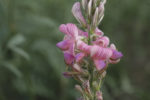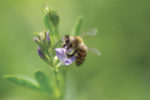Grasses & Legumes
A few years back, teff was receiving a lot of attention as the next great cattle forage. What do producers say now about the crop?
Read More
All those tiny bubbles: A look at bloat in livestock
Legume bloat in livestock occurs when fermentation gases form stable foam in the rumen, preventing gas release. This buildup causes rumen expansion, respiratory distress and can lead to death.
Read More
Mixing grasses and legumes to create more productive pastures
The increased fixed nitrogen, greater herbage mass, improved CP content, better digestibility and greater ability to meet nutritional needs make adding these versatile forages to your existing pasture grass an option worth considering.
Read More
Winter cereals for early spring grazing in an integrated livestock cropping system
Winter cereals provide excellent forage for livestock, either for grazing or to be hayed for roughage. They provide green, active growing plants during the fall and early winter periods, and extend the growing season of living plant roots in the soil.
Read More
Don’t let drought keep cattle performance down
Here are five considerations to help you efficiently deal with drought and optimize cattle performance on your operation.
Read More
The silver lining of drought
If nature has hit the reset button for you, then this is an opportunity to put your perennial pastures on a new and better trajectory.
Read More
Sainfoin in pastures for cattle – less risk for bloat
Many producers have had bad experiences with alfalfa and bloat, but with sainfoin added to a pasture, this risk is greatly reduced.
Read More
Silvopastures in the southeast U.S.
Ecosystem services provided by silvopastoral systems are mediated by specific management practices, environmental conditions and overall design of the system.
Read More
The essential bond between honeybees and forage crops
There is a crucial yet often underestimated role of pollinators, particularly honeybees, in forage crop production. While domestic and native colonies face growing challenges, farmers can implement practical strategies to preserve and enhance pollinator populations.
Read More








